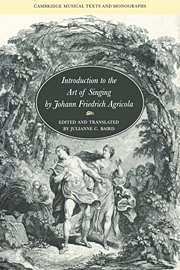Book contents
- Frontmatter
- Contents
- Acknowledgments
- Introduction: Agricola's treatise
- INTRODUCTION TO THE ART OF SINGING
- Translator's preface
- Foreword of the author
- Introduction of the author
- 1 Observations for the use of the singing teacher
- 2 Concerning appoggiaturas
- 3 Concerning trills
- 4 Concerning divisions
- 5 Concerning recitative
- 6 Remarks intended especially for the music student
- 7 Concerning arias
- 8 Concerning cadenzas
- 9 Remarks for the use of the professional singer
- 10 Concerning improvised variations of melodies
- Notes
- Bibliography
- Index
2 - Concerning appoggiaturas
Published online by Cambridge University Press: 10 December 2009
- Frontmatter
- Contents
- Acknowledgments
- Introduction: Agricola's treatise
- INTRODUCTION TO THE ART OF SINGING
- Translator's preface
- Foreword of the author
- Introduction of the author
- 1 Observations for the use of the singing teacher
- 2 Concerning appoggiaturas
- 3 Concerning trills
- 4 Concerning divisions
- 5 Concerning recitative
- 6 Remarks intended especially for the music student
- 7 Concerning arias
- 8 Concerning cadenzas
- 9 Remarks for the use of the professional singer
- 10 Concerning improvised variations of melodies
- Notes
- Bibliography
- Index
Summary
1. Of all the ornaments of singing, none is easier for the master to teach or for the student to learn than the appoggiatura. In addition to its pleasing quality, it alone in the art enjoys the privilege of being heard frequently without becoming tiresome to the listener, so long as it does not exceed the limits of good taste as prescribed by those who understand music.
2. Since the appoggiatura was invented to grace music, the reason why it cannot be used everywhere remains as yet undiscovered. After vainly seeking the answer from the best singers, I have concluded, since musical science must also have its rules [as do the other sciences], that we must do everything in our power to determine them. But assuming that I have not yet succeeded, connoisseurs of the art will at least find I have tried to approach my goal. The following rules come solely from my observation and thus beg greater indulgence in this chapter than in the others.
3. I know from experience that, within the diatonic scale, a singer can ascend and descend by means of the appoggiatura without any difficulty from one c to another through all of the five whole and the two half steps that constitute the octave.
4. That one can gradually ascend by half steps on every note marked with an accidental sharp, to the neighboring note, by means of an appoggiatura and return in the same manner.
- Type
- Chapter
- Information
- Publisher: Cambridge University PressPrint publication year: 1995

